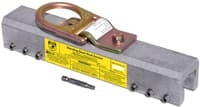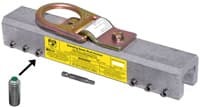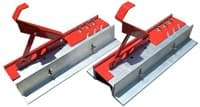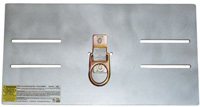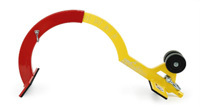Fall Protection Strategies For Corten Roofing SS675 Panels
Posted by Howie Scarboro - CEO Fall Protection Distributors, LLC on Apr 7th 2025
See the Roof Anchor Compatibility Chart for Corten Standing Seam Metal Roof Panels.

Who Is Corten Roofing?
Corten Roofing, a Western States Metal Roofing division, specializes in manufacturing and distributing weathering steel roofing and siding panels. The company is a trusted supplier of Corten steel, a material known for its ability to develop a protective rusted patina over time. This characteristic not only gives buildings a distinctive, rustic appearance but also enhances the longevity of the steel by preventing further corrosion.
Western States Metal Roofing, the parent company of Corten Roofing, was established in 1996 and initially operated as Western States Decking, Inc., a distributor of Verco metal decking products. Over time, the company expanded its focus to include metal roofing and siding. It became an industry leader in manufacturing weathering steel panels and products that mimic aged metal aesthetics. Corten Roofing continues this legacy by offering a range of panels designed for residential and commercial applications, providing architects, builders, and homeowners with high-quality materials that combine durability and striking visual appeal.
Corten Roofing's product lineup includes corrugated panels, standing seam roofing, and structural components made from ASTM-grade weathering steel, such as A606-4, A588, and A847. The company purchases Corten steel in large volumes, allowing it to pass cost savings on to customers. Its quick-shipping inventory and ability to provide custom panel widths and lengths make it a go-to source for Corten steel roofing projects.
Unlike pre-rusted alternatives, Corten Roofing panels are shipped unweathered and develop their patina naturally after installation. The company recommends a minimum roof slope of 3:12 for optimal performance, ensuring proper water drainage and longevity. With a reputation for quality products, competitive pricing, and expert customer service, Corten Roofing is a top supplier of weathering steel roofing and siding solutions.
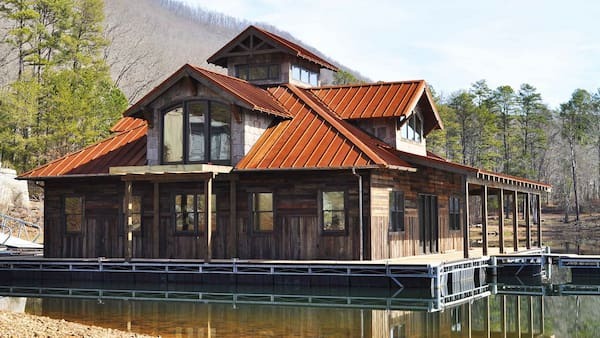
Why Are Compatible Fall Protection Anchors Critical for Standing Seam Roofs?
Corten standing seam roofs provide a unique combination of durability, weather resistance, and industrial aesthetics. Still, they require specialized fall protection solutions to ensure worker safety during installation and maintenance. Unlike traditional mechanically fastened roofing systems, standing seam panels use concealed clips, allowing thermal expansion and contraction. This floating design means that drilling or screwing into the panels can cause significant structural damage, leading to water leaks, corrosion, and voided warranties.
Many standard fall protection anchors require penetrating fasteners, which can compromise the protective rust layer of Corten steel, accelerating wear and reducing the roof's lifespan. To avoid these issues, non-penetrating seam-mounted fall protection anchors are the safest and most effective solution for workers operating on standing seam panels.
Choosing the right fall protection system is about more than just meeting OSHA compliance—it's about protecting workers and preserving the roof's long-term performance. Using non-penetrating solutions, contractors and roofing professionals can work safely and efficiently while maintaining the structural integrity and weather-resistant properties of Corten standing seam panels.
Corten SS675 Snaplock Panel Overview

The SS675 Snaplock Panel from Western States Metal Roofing is a premium standing seam roofing panel made from ASTM A606-4 Corten steel or Bare Cold Rolled Steel. This panel provides long-term durability and a unique, weathered appearance that develops naturally over time. It features concealed fasteners for a clean, uninterrupted look while allowing for thermal expansion and contraction. Unlike painted metal panels, which maintain a uniform color, the SS675 panel arrives with a dull gray finish and transforms through exposure to the elements. Over two to three years, the panel forms a protective rust patina that shields the underlying steel from further corrosion. The final patina varies depending on climate and moisture cycles, giving each installation a unique character. See the Roof Anchor Compatibility Chart for Corten SS675 Snaplock Standing Seam Metal Roof Panels.
This panel is available for alternative applications in 22-gauge ASTM A606-4 Corten steel, and 22 and 24-gauge bare cold rolled steel. The rib height measures 1.75 inches, with a standard width of 16 inches. Custom widths are also available, ranging from 12 to 24 inches. Lengths can be ordered between one foot and 52 feet to accommodate various architectural and structural needs. Installation requires a solid substrate with high-temperature underlayment and bead mastic on overlaps for roofing applications. The minimum recommended slope is 3:12 to ensure proper water drainage. Concealed stainless steel clips and screws, with brown-painted heads to blend with the final patina, provide secure attachment without disrupting the panel's appearance.
Corten steel performs best in environments with alternating wet and dry conditions, allowing the protective patina to develop correctly. It is unsuitable for coastal regions or areas with high salt exposure, as these conditions can prevent proper patina formation and accelerate corrosion. Rust runoff may also stain surrounding surfaces, making it essential to consider drainage solutions when installing the panels. The SS675 panel is widely used in architectural applications, including residential and commercial roofing, wall cladding, and accent features, delivering the look of aged steel while maintaining structural strength.
Fall Protection For SS675 Panels
The SSRA1 Seam Anchor, SSRA2 Adjustable Roof Jacks, and SSRA3 Anchor Plates provide a secure and non-penetrating fall protection system for the SS675 series of panels. The SSRA1 clamps onto the standing seam without drilling, maintaining the roof's structural integrity while creating a reliable worker tie-off point. Adapter plates expand the function of the SSRA1 to provide additional fall protection abilities for more challenging work environments. The SSRA2 Adjustable Roof Jack Adapters allow for installing 10-foot wooden walkboards, giving crews a flat walking surface to navigate the roof safely. The SSRA3 Anchor Plate attaches to the SSRA1, enabling a temporary 100-foot horizontal lifeline system. This combination ensures continuous tie-off for multiple workers, reducing fall risks while preserving the roof's weatherproofing.
The Ridge Pro Steep Assist is another excellent solution for the SS675 roof systems. It provides the most effective fall protection on roof slopes between 6/12 and 12/12. This system hooks securely over the roof peak without clamps or fasteners, eliminating the risk of panel damage. Workers can maintain 100% tie-off while moving across the roof, ensuring safety without compromising the structural integrity of the panels. The lightweight design makes repositioning easy as work progresses, providing flexibility while maintaining OSHA compliance. By choosing the appropriate fall protection system, contractors can protect workers while ensuring that the unique aesthetics and long-term durability of the SS675 panel remain intact.
Standing Seam Roof Anchor Point Compatibility for Corten
| SS675 Panel | |
|---|---|
| YES | |
| YES | |
| YES | |
| YES | |
| YES |
Contact Us For More Information
For further details on roofing solutions and fall protection systems, contact us at 863-703-4522 or www.StandingSeamRoofAnchor.com. Let's work together to make your roofing projects safe, beautiful, and built to last. For more safety tips, check out OSHA's 48-page fall protection manual. Once you have determined the most suitable anchors for your roof system, download our free Anchor Inspection Form.
Safety Tips For Standing Seam Roofs
Equip Workers with High-Quality Safety Gear
Providing workers with well-fitted, OSHA-compliant safety gear is the foundation of effective fall protection. Harnesses, lanyards, and self-retracting lifelines should meet safety standards and offer all-day comfort to encourage consistent use. When workers trust their equipment, they are more likely to wear it properly, reducing the risk of serious injuries.
Prioritize Ladder Safety Training
Falls from ladders account for a significant number of roofing-related injuries. Training workers to inspect ladders before use, position them at the correct angle, and maintain three points of contact minimizes these risks. Following the 4-to-1 rule and ensuring ladders rest on stable, level surfaces further enhances safety when accessing and exiting the roof.
Promote a Culture of Safety
A strong safety culture starts with leadership and filters through every team level. Encouraging open conversations about job-site hazards, hosting regular training sessions, and streamlining the process for reporting near misses create a proactive approach to accident prevention. When safety becomes a daily habit rather than an afterthought, workplace incidents decrease, and efficiency improves.
Set Up Protective Guardrail Barriers for Work Zones
Installing temporary guardrails or warning lines establishes clearly defined work zones, reducing the risk of accidental slips or missteps near roof edges or skylights. Guardrails are a passive fall protection measure, allowing workers to focus on tasks without worrying about fall hazards.
Develop OSHA-Compliant Safety Plans
Every roofing project should begin with a well-documented safety plan that outlines fall protection measures, emergency response procedures, and OSHA-compliant job-site protocols. Consistently reviewing and updating safety plans ensures that all team members understand best practices and remain prepared to handle potential hazards.
Use Specialized Anchor Systems for Standing Seam Roofs
Standing seam metal roofs require non-penetrating anchors. Clamp-style seam anchors provide secure tie-off points without compromising the roof's structural integrity. Using anchors that rely on hidden clips or improper attachment methods can create dangerous conditions, making it essential to choose the right equipment.
Encourage the Use of Trauma Straps
Trauma straps are a crucial addition to any fall protection system. They help reduce the effects of suspension trauma if a worker is left hanging after a fall. Employers should ensure that every harness includes adjustable trauma straps and proper worker training to deploy them properly. Using trauma straps helps maintain circulation and minimizes serious health risks while awaiting rescue.
Install Permanent Roof Anchor Systems
Permanent anchor points benefit buildings that require regular rooftop access. These fixed tie-off systems allow maintenance crews to quickly secure themselves without setting up temporary anchors for each visit. Investing in permanent fall protection solutions improves worker safety and the roofing system's longevity.
Ensure Proper Footwear for Stability
Proper footwear is one of the simplest yet most effective ways to prevent slips and falls on metal roofs. High-traction, slip-resistant boots provide the grip to navigate steep, slick, or uneven surfaces. Well-fitted footwear increases worker confidence and reduces unnecessary risks.
Consult Experts for Curved Metal Panels
Curved standing seam roofs present unique safety challenges that require specialized fall protection solutions. Before installing anchors or tie-off points, consulting with a trained safety expert ensures the use of correct methods. Expert guidance helps protect both workers and the roof's architectural integrity.
Disclaimer
The views, recommendations, and information presented in this blog are solely those of the author and do not necessarily reflect the opinions or positions of the featured panel manufacturer, its brands, subsidiaries, or parent companies. Customers are strongly encouraged to reach out directly to the roof panel manufacturer for inquiries regarding fall protection compatibility with their products and to address any potential warranty issues that may arise following the installation of our products.


